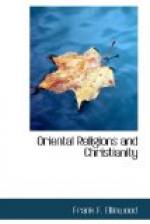The fact that in nearly every case those who were rescued from the flood immediately offered piacular sacrifices suggests the recognition in all human history of still another fundamental doctrine of Christianity, the universal sense of sin. This conviction was especially strong when the survivors of a Divine judgment beheld the spectacle of a race swept away for their transgressions; but there are abundant traces of it in all ages of the world. The exceptions are found in those instances where false systems of philosophy have sophisticated the natural sense of guilt by destroying the consciousness of personality. All races of men have shown a feeling of moral delinquency and a corresponding fear. The late C. Loring Brace, in his work entitled “The Unknown God,” quotes some striking penitential psalms or prayers offered by the Akkadians of Northern Assyria four thousand years ago.
The deep-seated conviction of guilt which is indicated by the old religion of the Egyptians is well set forth by Dr. John Wortabet, of Beyrut, in a pamphlet entitled “The Temples and Tombs of Thebes.” He says: “The immortality of the soul, its rewards and punishments in the next world, and its final salvation and return into the essence of the divinity were among the most cherished articles of the Egyptian creed. Here (in the tombs), as on the papyri which contain the ’Ritual of the Dead,’ are represented the passage of the soul through the nether world and its introduction into the Judgment Hall, where Osiris, the god of benevolence, sits on a throne, and with the assistance of forty-two assessors proceeds to examine the deceased. His actions are weighed in a balance against truth in the presence of Thoth, the ibis-headed god of wisdom, and if found wanting he is hounded out in the shape of an unclean animal by Anubis, the jackal-headed god of the infernal regions. The soul then proceeds in a series of transmigrations into the bodies of animals and human beings and thus passes through a purgatorial process which entitles it to appear again before the judgment-seat of Osiris. If found pure it is conveyed to Aalu, the Elysian fields, or the ’Pools of Peace.’ After three thousand years of sowing and reaping by cool waters it returns to its old body (the preserved mummy), suffers another period of probation, and is ultimately absorbed into the godhead. One of the most impressive scenes in the whole series is that where the soul, in the form of a mummified body, stands before Osiris and the forty-two judges to be examined on the forty-two commandments of the Egyptian religion. Bearing on its face the signs of solemnity and fear, and carrying in its hand a feather, the symbol of veracity, it says among other things: ’I have not blasphemed the gods, I have defrauded no man, I have not changed the measures of Egypt, I have not prevaricated at the courts of justice, I have not lied, I have not stolen, I have not committed adultery, I have done no murder,




